North Korean won facts for kids
Quick facts for kids North Korean won |
|
|---|---|
| ISO 4217 Code | KPW |
| User(s) | |
| Subunit | |
| 1⁄100 | chon (전 / 錢) |
| Symbol | ₩ |
| Coins | |
| Rarely used | 1, 5, 10, 50 chon; ₩1 |
| Banknotes | |
| Freq. used | ₩100, ₩200, ₩500, ₩1000, ₩2000, ₩5000 |
| Rarely used | ₩5, ₩10, ₩50 |
| Democratic People's Republic of Korea won | |
| Chosŏn'gŭl |
조선민주주의인민공화국 원
|
|---|---|
| Hancha |
朝鮮民主主義人民共和國 圓
|
| Revised Romanization | Joseon minjujuui inmin gonghwaguk won |
| McCune–Reischauer | Chosŏn minjujuŭi inmin konghwakuk wŏn |
| Korean People's won | |
| Chosŏn'gŭl |
조선 인민 원
|
| Hancha |
朝鮮 人民 圓
|
| Revised Romanization | Joseon-inmin won |
| McCune–Reischauer | Chosŏn-inmin wŏn |
The North Korean won (Symbol: ₩; Code: KPW) is the official money of North Korea. It is also called the Korean People's won. This money is split into 100 smaller units called chon. The Central Bank of the Democratic People's Republic of Korea in Pyongyang prints and manages the won.
Contents
What's in a Name?
The word Won comes from the Chinese word yuan. It means "round shape." This is because early coins were round. The smaller unit, chon, is also a Korean word.
A Brief History of the Won
North Korea started using its own money after Korea was divided. This happened in 1947. Before that, they used the Korean yen.
Early Won: 1947–2009
The first North Korean won was created in 1947. Then, in 1959, a second version was introduced. This new won was worth 100 old won.
For many years, the government tried to keep the won's value fixed. For example, they set it at 2.16 won for every US dollar. This number was even linked to Kim Jong Il's birthday.
However, over time, prices in North Korea went up a lot. This meant the won became worth less and less. By 2001, the government had to change its fixed rate. They started using rates closer to what people paid on the unofficial market.
The 2009 Money Change
In November 2009, North Korea changed its money again. This was the first time in 50 years. People were told they could exchange their old money for new money. But there was a limit on how much they could exchange.
This change caused problems for many people. Their savings lost a lot of value. Some people protested. The government said this change would help control prices. It was also meant to stop unofficial money trading.
During this time, old money stopped being valid. But new money was not given out right away. This meant people could not buy things for a week. Shops and restaurants closed. Only places for foreigners or important people stayed open.
This caused a lot of worry among North Koreans. There were reports of protests. The government then allowed people to exchange a bit more money. Pictures of the new money were shown in a newspaper in Japan. The newspaper said the change would make the country's socialist system stronger.
However, the won's value dropped sharply against the US dollar. Later, some rules about unofficial markets were made easier.
Coins of North Korea
North Korea has used different coins over the years.
Second Won Coins
The first coins for everyday use came out in 1959. They were in values of 1, 5, and 10 chon. Later, in 1978, 50 chon coins were made. These coins showed the Chollima Statue. In 1987, 1 won coins were introduced. These showed the Grand People's Study House. All these coins were made from aluminum.
After 2001, these coins were not used much. In 2005, a new set of coins came out. These were 5, 10, 50, and 100 won. They had simpler designs.
| Image | Value | Technical parameters | Description | Date of minted year | |||||
|---|---|---|---|---|---|---|---|---|---|
| Diameter | Composition | Obverse | Reverse | General issue (no star) |
Socialist visitor (1 star) |
Capitalist visitor (2 stars) |
Year last circulated |
||
 |
1 chon | 16 mm | Aluminium | State title, Coat of arms, year of minting | Value, (optionally, star(s)) | 1959, 1970 | 1959 | 1959 | ? |
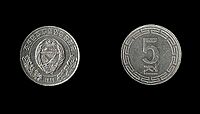 |
5 chon | 18 mm | 1959, 1974 | 1974 | 1974 | ? | |||
 |
10 chon | 20 mm | 1959 | 1959 | 1959 | ? | |||
| 50 chon | 25 mm | Bank title, Coat of arms, value | Chollima Statue, year of minting, (optionally, star(s)) |
1978 | 1978 | 1978 | ? | ||
  |
₩1 | 27 mm | Bank title, Coat of arms, value, year of minting | Grand People's Study House | 1987 | N/A | N/A | ? | |
  |
₩5 | 21 mm | Value | 2005 | N/A | N/A | 2009 | ||
  |
₩10 | 23 mm | 2005 | N/A | N/A | 2009 | |||
  |
₩50 | 25 mm | 2005 | N/A | N/A | 2009 | |||
  |
₩100 | 27 mm | 2005 | N/A | N/A | 2009 | |||
| For table standards, see the coin specification table. | |||||||||
North Korea also made special coins for foreign visitors. Some had one star for "socialist visitors." Others had two stars for "capitalist visitors." These were part of a system to control money for different groups.
Third Won Coins
New coins were made in 2002 and 2008. These were 1, 5, 10, 50 chon, and 1 won. All were made of aluminum. They show the national coat of arms on one side. The other side features flowers like the Kimjongilia and Kimilsungia.
These coins were meant to be used after the won's value was changed. But because of problems with the money change, these coins have very little value today.
| Image | Value | Technical parameters | Description | Date of minted year | |||
|---|---|---|---|---|---|---|---|
| Diameter | Mass | Composition | Obverse | Reverse | |||
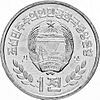 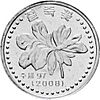 |
1 chon | 18.0 mm | 0.8 g | Aluminium | Coat of arms, Value | Royal azalea, Year of minting | 2008 |
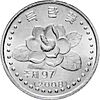 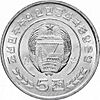 |
5 chon | 19.0 mm | 0.9 g | Tree peony, Year of minting | 2008 | ||
| 10 chon | 20.0 mm | 1.0 g | Azalea, Year of minting | 2002 | |||
| 50 chon | 22.1 mm | 1.55 g | Kimjongilia, Year of minting | 2002 | |||
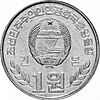 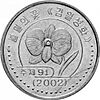 |
₩1 | 24.1 mm | 1.9 g | Kimilsungia, Year of minting | 2002 | ||
| For table standards, see the coin specification table. | |||||||
Banknotes of North Korea
North Korea has issued many different banknotes.
First Won Banknotes
The first banknotes were printed in 1947. They came in values like 15, 20, and 50 chon, and 1, 5, 10, and 100 won. The won notes showed a farmer and a worker together. In 1959, these notes were replaced because of inflation.
Second Won Banknotes
In 1959, new banknotes were released. These were 50 chon, and 1, 5, 10, 50, and 100 won. They were larger and showed different industries in North Korea.
In 1979, the money was changed again. New banknotes were made for 1, 5, 10, 50, and 100 won. The old banknotes were taken out of use. For the first time, Kim Il Sung appeared on the 100 won note.
In 1992, the banknotes were redesigned again. They were smaller and showed more modern pictures. Later, in 1998, 500 won notes were added. In 2002, 1,000 and 5,000 won notes came out. A 200 won note was added in 2005. From 1998, all notes also showed the Juche year.
| Obverse | Reverse | Main color | Value | Obverse | Reverse |
|---|---|---|---|---|---|
| Olive-green | ₩1 | A student, woman and children | Male and female soldiers; Yang Helyong (scenes from the opera Sea of Blood) | ||
| Blue-gray | ₩5 | Worker with a cogwheel and holding a political book; peasant woman holding a sheaf of wheat; factories in the background | Mount Kumgang | ||
| Brown | ₩10 | Chollima | Chollima Steel Complex | ||
| Olive-green | ₩50 | Soldier; peasant woman; officials of the Workers' Party of Korea | Lake | ||
| Brown and lilac | ₩100 | Kim Il Sung | Mangyongdae (the birthplace of Kim Il Sung) |
| Obverse | Reverse | Value | Dimensions | Main Color | Description | Date of issue | ||
|---|---|---|---|---|---|---|---|---|
| Obverse | Reverse | Watermark | ||||||
| ₩1 | 116 × 55 mm | Green | Actress Hong Yong-hee in her film role as The Flower Girl | Mount Kumgang | Chollima Statue | 1992 | ||
| ₩5 | 126 × 60 mm | Blue | Students, Kim Il Sung University, Mangyongdae School Children's Palace | Grand People's Study House | 1992 | |||
| 1998 | ||||||||
| ₩10 | 136 × 65 mm | Brown-orange | Factory worker, Chollima (1,000 ri horse) | Pi Do Island, Western sea barrage and locks at Taedong River(Taedong-gang) | 1992 | |||
| 1998 | ||||||||
| ₩50 | 146 × 70 mm | Orange | Young professionals, Juche Tower | Mount Paektu | Juche Tower | 1992 | ||
| ₩100 | 156 × 75 mm | Red and brown | Kim Il Sung | The birthplace of Kim Il Sung, Mangyongdae-guyok | Arch of Triumph | 1992 | ||
| ₩200 | 140 × 72 mm | Blue and green | Mongnan (National Flower of North Korea) | Value | Chollima Statue | 2005 | ||
| ₩500 | 156 × 75 mm | Dark green | Kumsusan Memorial Palace | Chongryu Bridge | Arch of Triumph | 1998 | ||
| 2007 | ||||||||
| ₩1000 | Green-cyan | Kim Il Sung | The birthplace of Kim Il Sung, Mangyongdae-guyok | 2002 | ||||
| 2006 | ||||||||
| ₩5000 | Violet | 2002 | ||||||
| 2006 | ||||||||
Third Won Banknotes
In 2009, North Korea changed its money again. This was to deal with rising prices and unofficial trading. This change caused problems for many people's savings.
Some of these banknotes were actually printed in 2002. This suggests that a money change was planned much earlier.
The current banknotes come in values from 5 to 5,000 won. Only the highest value note shows Kim Il Sung. Other notes show the national flower, the Magnolia. They also show North Koreans doing different jobs and famous monuments. One new won was worth 100 old won.
In 2014, a new 5,000 won note was released. This note shows Kim Il Sung's birthplace. The back shows a building where gifts from foreign leaders are displayed. This change was made to help fight fake money.
| Value | Dimensions | Main colour | Description | Date of | Ref. | ||||
|---|---|---|---|---|---|---|---|---|---|
| Obverse | Reverse | Watermark | printing | issue | |||||
| ₩5 | 145 × 65 mm | Navy blue | Atomic symbol, Party members | Hwanggang Hydroelectric Dam | Mongnan | Juche 91 (2002) |
30 November 2009 | ||
| ₩10 | 145 × 65 mm | Olive green | Korean People's Army Ground Force emblem, Soldiers (Air Force, Navy, Army) | Statue of Victory in Pyongyang | Mongnan | Juche 91 (2002) |
30 November 2009 | ||
| ₩50 | 145 × 65 mm | Indigo | Flame from the Juche Tower in Pyongyang, Man in business suit, Man in overalls, Woman | Monument to Party Founding in Pyongyang | Mongnan | Juche 91 (2002) |
30 November 2009 | ||
| ₩100 | 145 × 65 mm | Green | Mongnan (Magnolia sieboldii) | Denomination | Mongnan | Juche 97 (2008) |
30 November 2009 | ||
| ₩200 | 145 × 65 mm | Violet | Chollima Statue in Pyongyang | Denomination | Mongnan | Juche 97 (2008) |
30 November 2009 | ||
| ₩500 | 145 × 65 mm | Grey | Arch of Triumph in Pyongyang | Denomination | Mongnan | Juche 97 (2008) |
30 November 2009 | ||
| ₩1,000 | 145 × 65 mm | Pink | Birthplace of Kim Jong-suk in Hoeryong | Trees on the shore of Samji Lake | Mongnan | Juche 97 (2008) |
30 November 2009 | ||
| ₩2,000 | 145 × 65 mm | Blue | Alleged birthplace of Kim Jong Il, Jong-il Peak | Paektu Mountain | Mongnan | Juche 97 (2008) |
30 November 2009 | ||
| ₩5,000 | 145 × 65 mm | Brown | Star, Kim Il Sung, Mongnan (Magnolia sieboldii) | Mangyongdae (alleged birthplace of Kim Il Sung) in Pyongyang | Mongnan | Juche 97 (2008) |
30 November 2009 | ||
| Mangyongdae (alleged birthplace of Kim Il Sung) in Pyongyang | International Friendship Exhibition at Mount Myohyang | Juche 102 (2013) |
2014 | ||||||
| For table standards, see the banknote specification table. | |||||||||
Emergency Money: Donpyo
Because of recent global events, North Korea faced shortages of ink and paper. This made it hard to print regular won banknotes. So, in 2021, they started using "money coupons" called donpyo. These coupons are in 5,000 and 50,000 won values. They are printed on lower quality paper.
These donpyo are worth less than regular won banknotes in unofficial markets.
How Much is the Won Worth?
The North Korean won is not traded on international markets. This means you cannot easily exchange it in other countries. In unofficial markets, its value changes. For example, in 2019, about 8,000 North Korean won were worth 1 US dollar. Later, its value went up a bit.
Using Foreign Money in North Korea
Before 2009, North Korean won was mostly for North Korean citizens. Visitors used special money called "foreign exchange certificates." There were two types: one for visitors from "socialist countries" (red) and one for "capitalist countries" (blue/green).
These special certificates were used until 1999. After that, visitors could pay directly with foreign money.
Money Use Since 2009
After the 2009 money change, some stores in Pyongyang only accepted foreign money. This included Japanese yen and US dollars. By 2018, most stores accepted US dollars, euros, and Chinese yuan. Change was often given in yuan or US dollars.
Foreign visitors can use a special debit card. This card is linked to foreign money exchanged at an official rate. This "tied won" is not actual banknotes. It is just a way to keep track of money for foreigners.
In regular stores and markets, prices are in "untied" won. This is the regular North Korean won banknotes. There are places where you can exchange foreign money for these regular banknotes. The exchange rate for "untied" won is much different from the official rate.
See also
- Economy of North Korea
- South Korean won

